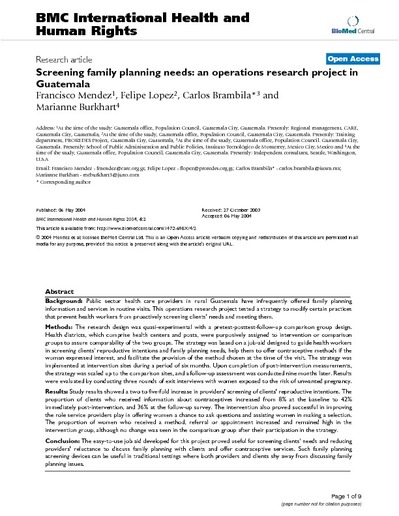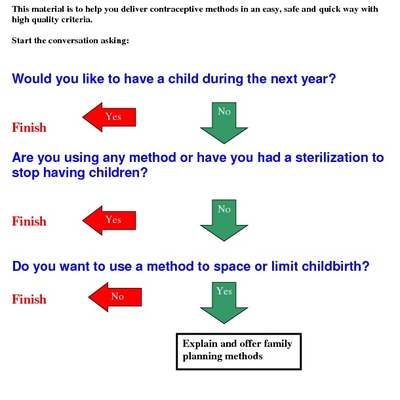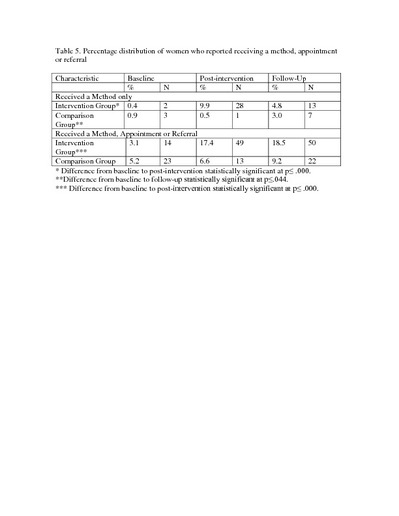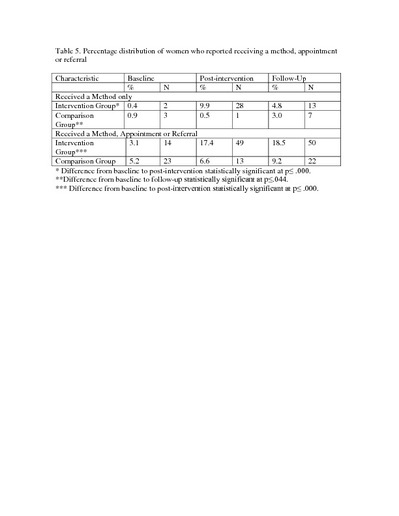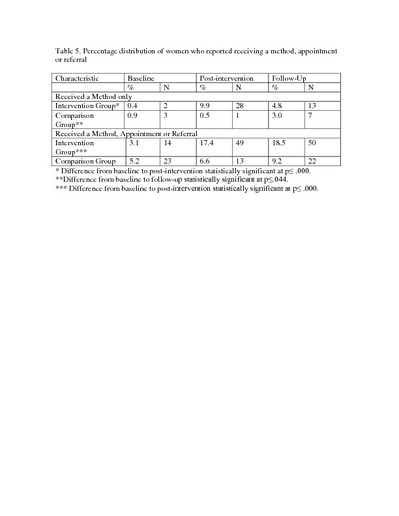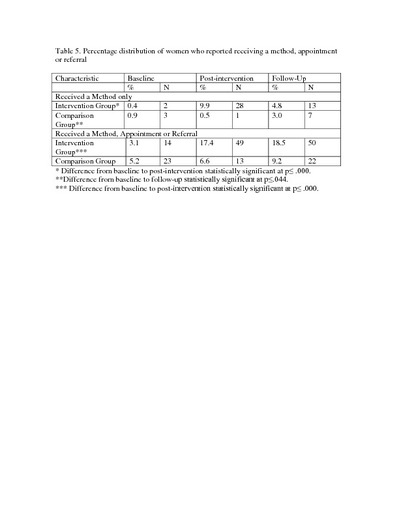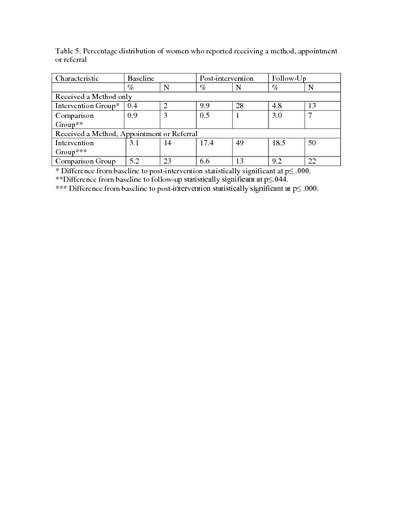| dc.contributor.author | Mendez, Francisco | en |
| dc.contributor.author | López, Felipe | en |
| dc.contributor.author | Brambila Paz, Carlos | en |
| dc.contributor.author | Burkhart, Marianne | en |
| dc.date.accessioned | 2016-06-20T03:17:24Z | |
| dc.date.available | 2016-06-20T03:17:24Z | |
| dc.date.issued | 06/05/2004 | |
| dc.identifier.other | BMC International Health and Human Rights. 2004 May 06;4(1):2 | |
| dc.identifier.uri | http://dx.doi.org/10.1186/1472-698X-4-2 | |
| dc.identifier.uri | http://hdl.handle.net/11285/613663 | |
| dc.description.abstract | Abstract Background Public sector health care providers in rural Guatemala have infrequently offered family planning information and services in routine visits. This operations research project tested a strategy to modify certain practices that prevent health workers from proactively screening clients' needs and meeting them. Methods The research design was quasi-experimental with a pretest-posttest-follow-up comparison group design. Health districts, which comprise health centers and posts, were purposively assigned to intervention or comparison groups to assure comparability of the two groups. The strategy was based on a job-aid designed to guide health workers in screening clients' reproductive intentions and family planning needs, help them to offer contraceptive methods if the woman expressed interest, and facilitate the provision of the method chosen at the time of the visit. The strategy was implemented at intervention sites during a period of six months. Upon completion of post-intervention measurements, the strategy was scaled up to the comparison sites, and a follow-up assessment was conducted nine months later. Results were evaluated by conducting three rounds of exit interviews with women exposed to the risk of unwanted pregnancy. Results Study results showed a two to five-fold increase in providers' screening of clients' reproductive intentions. The proportion of clients who received information about contraceptives increased from 8% at the baseline to 42% immediately post-intervention, and 36% at the follow-up survey. The intervention also proved successful in improving the role service providers play in offering women a chance to ask questions and assisting women in making a selection. The proportion of women who received a method, referral or appointment increased and remained high in the intervention group, although no change was seen in the comparison group after their participation in the strategy. Conclusion The easy-to-use job aid developed for this project proved useful for screening clients' needs and reducing providers' reluctance to discuss family planning with clients and offer contraceptive services. Such family planning screening devices can be useful in traditional settings where both providers and clients shy away from discussing family planning issues. | |
| dc.language.iso | eng | en |
| dc.publisher | Open Access Publisher | en |
| dc.relation.url | http://bmcinthealthhumrights.biomedcentral.com/articles/10.1186/1472-698X-4-2 | en |
| dc.rights.uri | http://creativecommons.org/licenses/by-nc-nd/4.0/ | * |
| dc.title | Screening family planning needs: an operations research project in Guatemala | en |
| dc.type | Artículo / Article | en |
| dc.contributor.department | Tecnologico de Monterrey | en |
| dc.rights.holder | Mendez et al; licensee BioMed Central Ltd. | |
| dc.date.updated | 2016-06-01T12:18:36Z | |
| dc.subject.keyword | Family planning | en |
| dc.subject.keyword | Operations research | en |
| dc.subject.keyword | Reproductive health | en |
| dc.subject.keyword | Guatemala | en |
| dc.subject.discipline | Ciencias de la Salud / Health Sciences | |
| refterms.dateFOA | 2018-03-25T04:01:16Z | |
| html.description.abstract | Abstract Background Public sector health care providers in rural Guatemala have infrequently offered family planning information and services in routine visits. This operations research project tested a strategy to modify certain practices that prevent health workers from proactively screening clients' needs and meeting them. Methods The research design was quasi-experimental with a pretest-posttest-follow-up comparison group design. Health districts, which comprise health centers and posts, were purposively assigned to intervention or comparison groups to assure comparability of the two groups. The strategy was based on a job-aid designed to guide health workers in screening clients' reproductive intentions and family planning needs, help them to offer contraceptive methods if the woman expressed interest, and facilitate the provision of the method chosen at the time of the visit. The strategy was implemented at intervention sites during a period of six months. Upon completion of post-intervention measurements, the strategy was scaled up to the comparison sites, and a follow-up assessment was conducted nine months later. Results were evaluated by conducting three rounds of exit interviews with women exposed to the risk of unwanted pregnancy. Results Study results showed a two to five-fold increase in providers' screening of clients' reproductive intentions. The proportion of clients who received information about contraceptives increased from 8% at the baseline to 42% immediately post-intervention, and 36% at the follow-up survey. The intervention also proved successful in improving the role service providers play in offering women a chance to ask questions and assisting women in making a selection. The proportion of women who received a method, referral or appointment increased and remained high in the intervention group, although no change was seen in the comparison group after their participation in the strategy. Conclusion The easy-to-use job aid developed for this project proved useful for screening clients' needs and reducing providers' reluctance to discuss family planning with clients and offer contraceptive services. Such family planning screening devices can be useful in traditional settings where both providers and clients shy away from discussing family planning issues. | |
